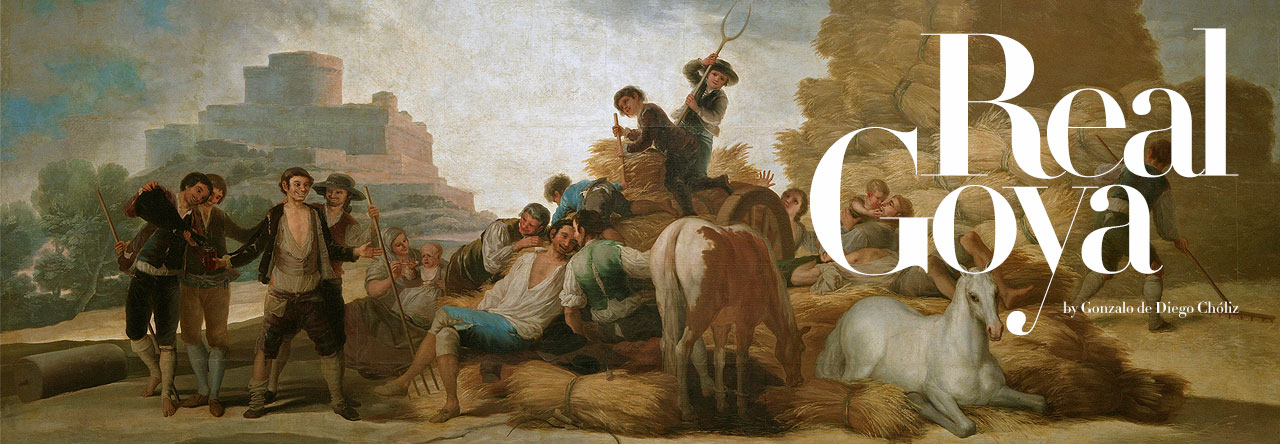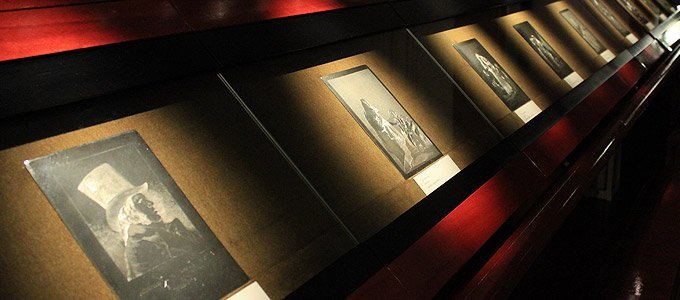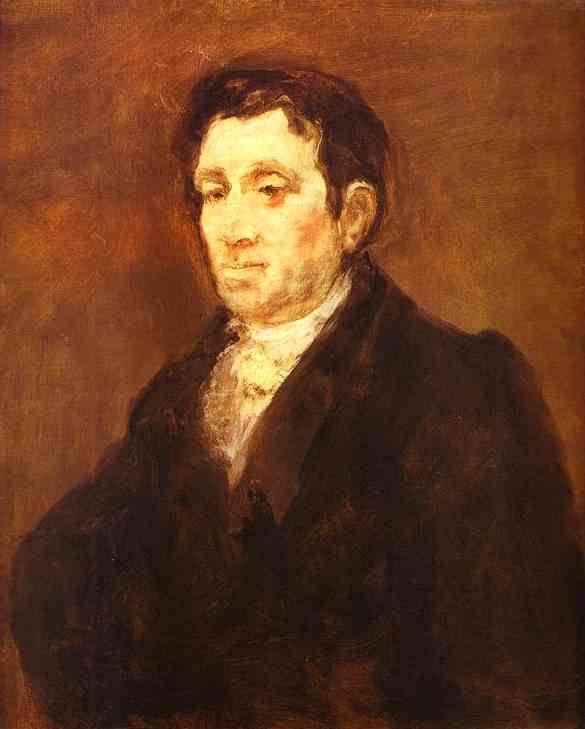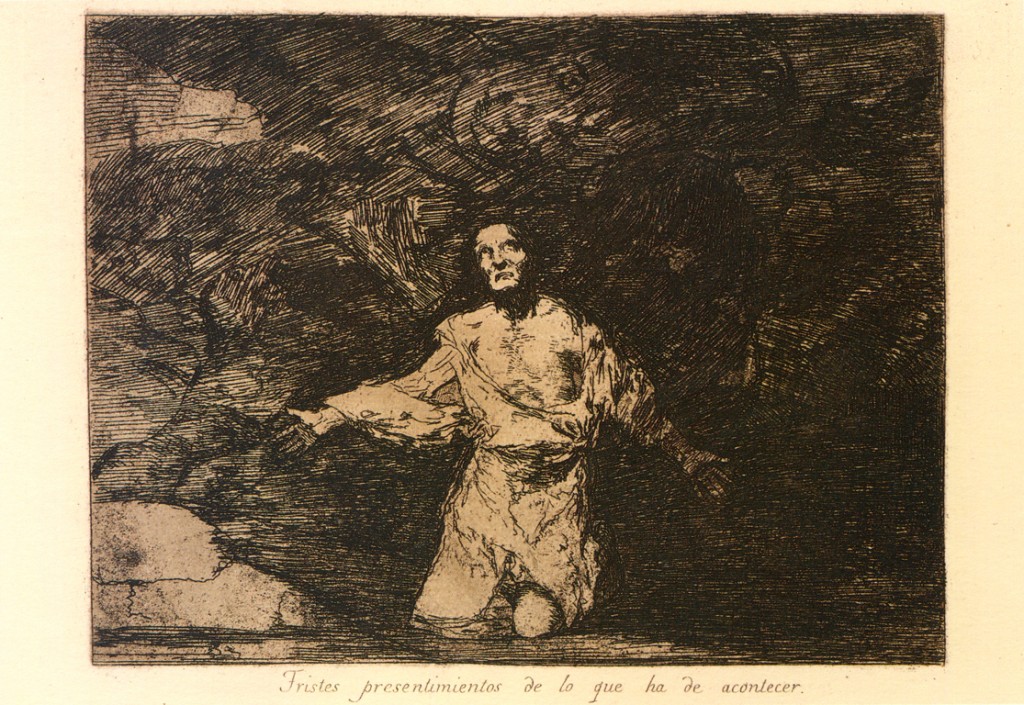
Tristes presentimientos de lo que ha de acontecer
Aguafuerte, punta seca, buril y bruñidor 178 x 220 mm.
Sad Presentiments of What is to Come.
Etching, burin, drypoint and burnisher.
All or almost has been said already about Goya. It is impossible to add something to what was said. These lines are not a comment from a specialist but from an artist who has had “encounters” over nearly forty years with Don Francisco de Goya, rather, with his work.
Beginning in the 1960s began editing in Argentina the collection “La Pinacoteca de los Genios” (‘The Art Gallery of the Genius’). My godfather Manuel, distributor of newspapers and magazines, gave me the first issues, among them the one devoted to Goya.
In the 1970s, the Latin American Publishing Center issued some magazines about graphic techniques. In 1973 I had not finished yet my degree at the Fine Arts faculty when one day I found several copies dedicated to engravings by Goya. I bought with a companion of studies four of them, two for each one. Those who I took home were referred to ‘The Disasters of War’. I knew the painting of Goya through books and “La Pinacoteca” (the Art Gallery), but not “discovered” yet the engravings, perhaps I had seen them but not understood. The impact of those images was emotionally intense. I had strange dreams from that vision, and same happened to my friend.
The social and political atmosphere we lived then in Argentina was violent and dangerous. “Tristes presentimientos de lo que ha de acontecer” (“Sad Presentiments of What is to Come”) was an announcement of what happened very shortly thereafter.
Goya is raw, realistic, not horrified, he sees, record, for him and for us. Terrible scenes beautifully engraved.
He and others were witnesses, then we also went and we continue to our shame.
I then looked with passion and admiration “Los Caprichos, Los Disparates” (‘The Caprices, The Nonsense’), and later, in Galleria degli Uffizzi, I was delighted with his painting, his wonderful flown brushstroke, subtle, rich, what fabrics! What jewels those small shoes…!
Later, already in Barcelona, I worked myself the engraving returned again and again to Don Francisco, and was a renewed vision. I did many sketches in tempera, black and white, lights and shadows, “studying” those amazing prints. I never used them for my work, but it developed in me the taste for the austerity of black and white to express what one considers essential.
In those years, a visit to the National Chalcography allowed me to meet the then newly opened “Temple” devoted to the plates of the master. Under a red-tinted light, I stared at these plates worked with an exquisite delicacy that surprised me because it left suspended the extreme violence of the printout on the paper. The plates are now treated steel, but we, the engravers, know that copper shines behind.
In my studio Ataúlfo 10, in Barcelona, I spent many years engraving and by chance I came a noon in June, sovereign sun, to Fuendetodos. That dry and severe landscape, flooded of light, impressed me. Energetic, powerful in its apparent poverty.
Then I taught several courses of etching techniques in the studio named now Antonio Saura, in tribute to that artist whom I have always admired as one of my masters whose devotion to Goya is known. His tribute to “Aún aprendo” (“Still learning”) has been a proof of this and also the countless mentions throughout his work.
Understanding an artist requires time and time changes our perception. Large amount of images I devoured in my youth, and often many come back and help me to better understand while they are interwoven with each other.
I have not returned to see the black paintings in the Prado Museum since in the late 1970s they changed their frames, which in my opinion was fatal. It also complained, long years ago, precisely by Antonio Saura.
There are works that when discovered produce great excitement and one don’t want to see them again, perhaps for fear of not being touched with the same intensity. Something like this happened to me with the black paintings. However, to the engravings I come back always, and also to the lithographs, because for more than twenty years that I am each day with stones, teaching and doing. It’s a pity that Goya was already an old man when he met lithographic art, but his way of working was already renewal since the beginning.
A few years ago I had the fortune to see, during its restoration, the dome Regina Martirum in El Pilar, Zaragoza. There’s a surprising Goya by its historical proximity, i.e. by its modernity. All the great masters have jumped the borders of their era at some point, becoming for us, “modern”, a term this led and brought that added nothing to the understanding of his work if not previously understood what it means to be modern. The broad brushstroke, oblivious to all the unnecessary, the self-assurance, spontaneity and richness of color, the “brushstrokes”, that others also used, but in him is a gesture of anticipatory breach. And even that it was an order!
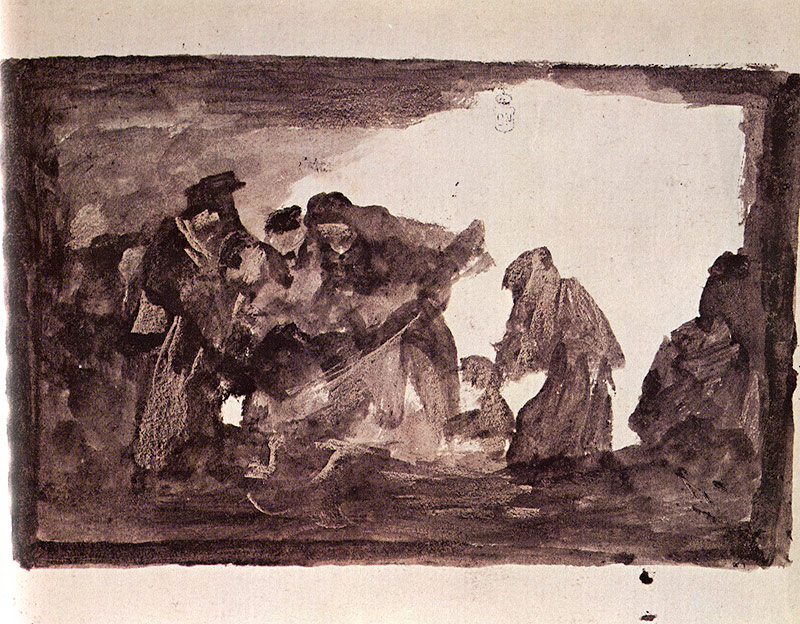
Grupo de personajes a contraluz, a la entrada de una cueva.
Aguada a tinta china con pincel. 160 x 230mm.
A group of characters to backlight, at the entrance of a cave.
Gouache ink with brush.
And today I have come back to look at gouache ink drawings, magnificent by its liveliness, its throb and his grace, and these qualities, that freshness of ink that appears even damp, remind me much to Hokusai, where drawing throbs in the gait of passers-by, in the fireworks on those nights of full moon, and how those peasants steep in the rain… It never rains in Japan as it does in Hokusai or Kurosawa.
There is nothing in Goya that get us closer to nature. Of course, I am sensitive to the landscape, so I liked that Gonzalo de Diego reflection about the landscape background of so many horrific scenes, that called rightly, no landscapes, which are just backdrops or sceneries, an almost theatrical background without too much presence. Goya is interested in the human being, not nature. And there are those portraits, the characters crossed by his gaze up to leave only the main, essential trait, and as an example, the portrait of José Pío de Molina painted in 1828, one of his last paintings at the age of 82, with eyes already worn, and so wise.
Silvia Pagliano
January 2013
